THIS MONTH’S SPECIAL
Another deer season has come and gone, and we now move into the period of roughly three months Grandpa Joe used to label as “a time of miseries,” “cabin fever time,” or other derisive terms. He had a point, because in the Smokies to an even greater degree than most places, the early portion of the new year was gray, grim, and in some ways soul destroying. My escape was always a good book, and that’s one thing that hasn’t changed a bit over the years.
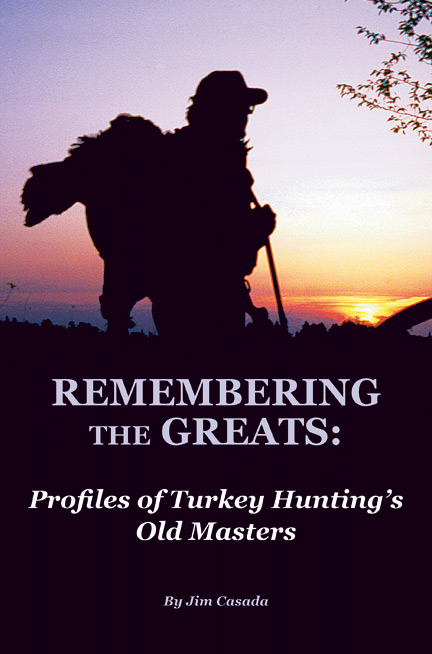
This month’s special is what I consider a “good book,” although you need to keep in mind that since I’m the author my judgment is highly questionable. Be that as it may, Remembering the Greats: Profiles of Turkey Hunting’s Old Masters won a couple awards when it came out, and every serious turkey hunter who has read it has had good things to say about the book. It profiles twenty-seven of the great names in the sport, all of them now gone to a place where it’s forever spring and turkeys gobble eternally. I was fortunate enough to know and hunt with a number of them. I’m offering the book for $24, postage paid, which is a significant discount from the regular price (with shipping, it’s normally $45). For this special offer, no PayPal please—just personal checks or money orders. South Carolina residents will need to add 7% ($1.68) for state tax.
**********************************************************************************
NEW YEAR, NEW DECADE, AND NEWS
(BUT I STILL CLING TO YESTERYEAR)
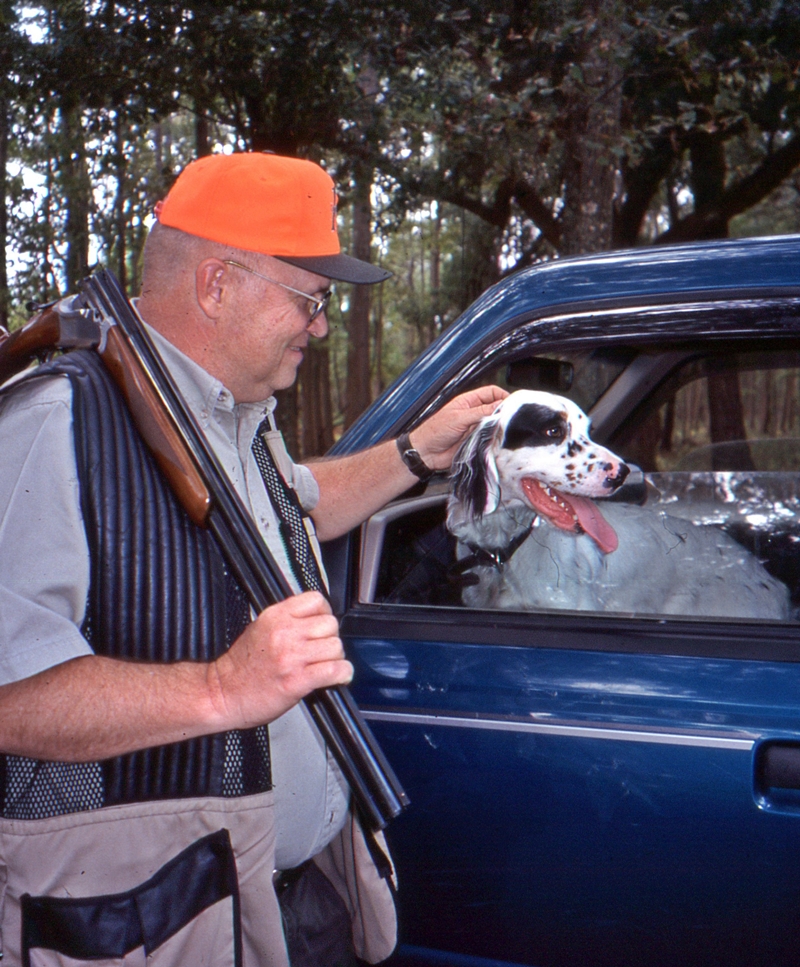
The word “new” is emphasized in my title for this month’s newsletter, and with that as an emphasis you’ll hopefully notice several things new. You can’t make a silk purse or a suave, sophisticated gentleman out of this old hillbilly, no matter how hard you try or how much photo-shopping you do. However, I can give you a new take on homely with a different image, and that’s what you get for starters.
Also, another something which is new is an opportunity to give me what in effect amounts to an advance order for my next book, “A Smokies Boyhood and Beyond: Mountain Musings, Memories, and More.” All you need to do is contact me (jimcasada@comporium.net) and let me know you want to be notified as soon as the book appears. I’ll promise you that as soon as I have finished copies in hand, which likely will be sometime this coming fall, you will hear from me. There’s no obligation to buy, no commitment of any kind, and nothing other than my indicating I’ll let you know.
Along those lines, and again this is new, I want to encourage you, as readers, to interact more with me. Some of you send a message almost every time there’s a new e-newsletter, but I’d love to hear from more of you. I’d welcome suggestions of topics, things you would like to see covered on a regular basis, shared memories, your stories, criticism (you’ll never be able to wound as deeply as an editor did early on in my career when he said I’d “do myself and mankind in general a favor if I never wrote another word,” so I’m not worried on that score), or indeed any kind of input. I love to hear from you and in general try to respond.
I should also note that I’m joining forces with longtime friend, webmaster, and culinary expert Tipper Pressley in what we hope will become a first-rate Appalachian cookbook. In that regard, let us know about foodstuffs you would like to see covered. We won’t offer any guarantees of a recipe from either of our kitchens, but at the very least we’ll give it some thought and consideration. She mentioned this effort in one of her recent blogs and two or three people immediately said they’d buy the book just to get a good recipe for chocolate gravy. She’s also got a “can’t fail” recipe for biscuits, one for chocolate gravy, a passel of soup offerings, and more. Hopefully I can bring in a few things special to help out in the overall project. We’ll keep you informed but right now we’d love to have your thoughts.
That’s enough of the “new.” If there has been one constant in this newsletter over the period I’ve been preparing it—amazingly I just checked and I began way back in September, 2004—it has been a nostalgic refrain. I look back with what some might consider inordinate fondness to what for me were, in a very real sense, the good old days. Mine was a magical boyhood, made that way by loving and highly capable parents, paternal grandparents who meant a great deal to me, and a veritable host of mentors in the form of teachers, Dad’s hunting and fishing companions, some old codgers, a handful of the gang at Loafer’s Glory who approach reprobate status, and some great teachers. Add to that the unquestioned blessing of growing up in what mountain poet and the father of a close childhood buddy of mine, Leroy Sossamon, described as “the backside of heaven,” and I guess it’s small wonder I cling tenaciously to so much that was associated with yesteryear.
With that thought in mind, the material which follows is a small sampling of the contents of “A Smokies Boyhood and Beyond.” It is one of twelve pieces covering the months of the year that make up a longish chapter entitled “Musings on the Months.” The chapter is one of four in a section titled “Seasons of the Smokies.” The others are “A Land of Delightful Variety,” “Weather Wisdom,” and “Smoky Mountain Rain.” I include it for two reasons. First, because this is a January e-newsletter it is topically suitable. Second, it is an opportunity to get an idea of the nature and thrust of the book’s contents.
*******************************************************************************
For me, January will always be more a month for reflection than resolutions, and as my years grow longer and my hair becomes thinner and whiter, living in the past becomes increasingly pleasant. During my boyhood, January was a time of year when Grandpa Joe would ease close to the fire in the living room (we’d never heard of a “den” except as a place bears holed up when the weather turned bitter). He would get settled comfortably in his rocking chair and, if the weather was inclement, pay a bit of grudging verbal tribute to “Uncle Arthur” (arthritis) or the “miseries.” The latter word embraced a whole litany of ailments—chest colds, rheumatism, arthritis, general cases of the mollygrubs, or just not feeling particularly pert. Since he most frequently talked about miseries when it was cold, with either a chilling rain or snow falling, I suspect that most of his trouble centered on arthritis.
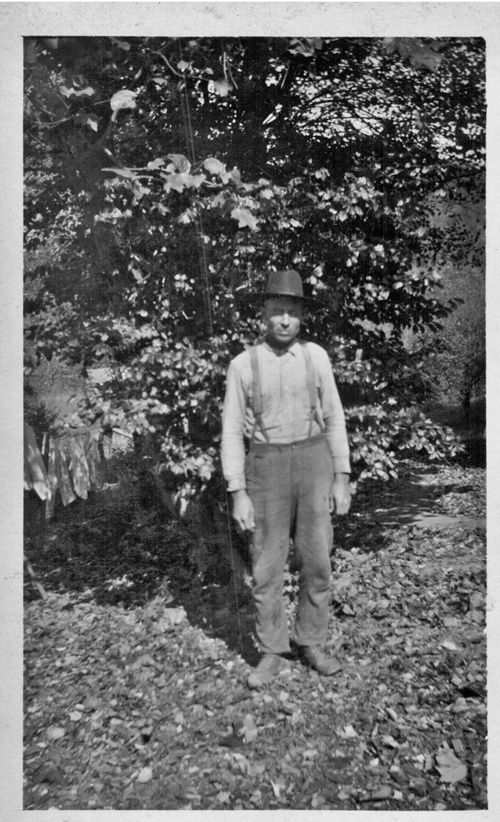
Grandpa Joe
Overall though, Grandpa wasn’t much of one for complaining. He was tough as a hickory hoe handle and about as inured to pain as any human you are likely to encounter. Even when he shattered his hip while out squirrel hunting and had to slide and crawl through snow just to get to the road, he refused any kind of pain relief in the aftermath of orthopedic surgery. Folks at Swain County Hospital found this so remarkable they commented: “That is sure one tough old man.”
While Grandpa was far removed from hypochondria, he was powerfully given to philosophizing. So fiercely independent he couldn’t and wouldn’t work for another man, he took orders from no one but Grandma Minnie (and did that reluctantly and irregularly). He distrusted any and all government authority, an approach that seems increasingly wise to me with each passing year, had more than a streak of paranoia, and when someone disagreed with him was regularly given to a pithy pronouncement: “You’ll learn!”
As his attentive one-person audience, sometime understudy, and regular sidekick, none of these examples of being what mountain folks sometimes describe as quare bothered me a bit. We got along just fine whatever the season, but one of my favorite times of the year to be with Grandpa Joe was January. There wasn’t much work to be done other than occasionally tending the fire or feeding the chickens and hogs. As a result I could sit in comfort and listen to hour upon hour of gripping stories.
Grandpa’s voice was barely above a whisper, and I had long thought that was just his peculiarity until recently coming across a recording of Granville Calhoun. Made when that grand old sage of Hazel Creek was 90 years of age (he lived to 103), it provides remarkable listening. In the recorded interview Calhoun sounds a great deal like Grandpa did, and his voice is soft as chamois. Yet straining to hear and understand what he said is worth every bit of the required effort. Other than a slight difference in accent, when listening to Calhoun I could have been back in the 1950s sitting alongside Grandpa.
As old men are wont to do, and I find myself increasingly guilty on this score, Grandpa talked primarily about things he had experienced over the course of his life, with a distinct and no doubt intentional focus on January. Here is a compendium of some of the joys he recalled. I have no way of knowing how truthful they were. I can merely note that although Grandpa certainly knew how to embellish, he also was a stickler for factual accuracy. Wherever the boundary between fact and fiction lay in his tales, it really doesn’t matter after the passage of more than half a century.
He talked of killing a “painter” (panther) when he was a young man, and described the scream of a cougar so accurately it sent chills down my spine. “It was like the cry of a woman dying,” was the way he put it.
He recounted glory days of the American chestnut, when mast was so plentiful that his family, along with every other one earning a hardscrabble living in the high country, gathered great quantities of the nuts in the fall to sell and eat through the winter. “A bait of roasted chestnuts on a cold winter day,” he would say, “made for some mighty fine eating.”
Food figured prominently in other parts of his monologue as well. Grandpa could speak of simple mountain vittles in a fashion that invariably had me all primed to eat when Grandma called us for dinner or supper. Of course the fact that she was a splendid cook and that I was permanently peckish didn’t hurt.
I loved his oft-recounted tale of a massive snowfall of some three feet. It was of the soft, fluffy kind and so deep rabbits couldn’t run. He and his brother caught a whole sack full of cottontails in that snow.
Speaking of rabbits, often during those joyful January days Grandpa and I constructed rabbit gums. Merely thinking of those devices leads me to wonder whether anyone makes and uses these simple, effective traps anymore.
Grandpa was greatly given to whittling, and often as he talked he worked on a piece of wood. He might be shaping the beginnings of a flutter mill or fashioning a Jacob’s ladder, but one of his favorite projects was shaping and notching, ever so carefully, a dogwood fork. Dogwood is a dense, extremely hard wood (so much so that old-timers often used a section of it as a wedge when splitting firewood), and that meant the whittling process was a slow, tedious one. Yet patience and persistence were bywords for Grandpa—he never, ever hurried—and steady whittling, possibly with a bit of attention from a whetstone if his knife’s performance didn’t suit his exacting standards, perfectly suited his demeanor when in a tale-telling mode. Once he had the dogwood fork shaped to satisfaction, all the piece of wood required was to be outfitted with some inner tube rubber, stout twine, and a rectangular piece of leather. The end result was a fine slingshot.
Eventually Grandpa would tire of talking, perhaps with a nap in mind, and at that point he’d gently shoo me out of the house. “Cold January days,” he would say, “are a time for young boys to plunder about and maybe see if they can find a squirrel or jump a rabbit. They are also a time for old folks like me to hang close to a warm fire with a cup of Rooshian (Russian) tea.”
Those naps hadn’t always been his practice, but an event from a January day when he was well into his seventies, briefly alluded to above, needs to be shared as a sort of wrap-up to this month as well as an explanation of his suggestion that it was the duty of the young to take care of outdoor rambling in the dead of winter.
Grandpa Joe had always loved to squirrel hunt, and it was something he pursued with a passion that never dimmed despite the toll of advancing years and aching joints. When he shared hunting stories, sooner or later Grandpa would harken back to the time when the American chestnut reigned supreme in mountain forests and when squirrels were incredibly abundant. I guess you could say he was looking back to the “good old days” in his own way. Even though bushytails numbers weren’t what they had once been by the time we were staunch partners separated by a generation, he still hunted them with a will. Time and again I heard him say “a mess of squirrel flanked by a platter of cathead biscuits, a bunch of baked sweet potatoes, and some of your Grandma’s squirrel gravy” was about as near to culinary heaven as a body was likely to get.
It was on an early January day, bitterly cold and with a skiff of freshly fallen snow on the ground, that the urge for such a meal seized Grandpa’s fancy. He set out from the house with his trusty little .22, never mind the temperatures in the twenties or the snow. Alas, the trip went bad in a big way. Grandpa slipped and fell, perhaps a half mile from the nearest road, and shattered his hip. Somehow he managed to slide and crawl through the snow until he got to old U. S. Highway 19 above Bryson City. He yelled and waved for help as one car after another passed by, but since he was high atop a bank where the road had cut through a ridge, no one noticed him. Finally, realizing something had to be done, Grandpa gritted his teeth, turned on his side to his uninjured hip, and slid down the steep bank to the roadside. From there he was transported to the hospital.
Somehow this tough old man survived the ordeal, and folks at the hospital told my father they had never treated anyone with a higher tolerance for pain. Once he came out of anesthesia used to repair his hip, Grandpa refused any and all pain medication. Eventually he was able to walk again and get about quite well, although it took a bit of a mean trick—my sister and I hiding a crutch on which he had become overly dependent—for him to realize he was pretty well back to his pre-accident status. Predictably, given a stubborn mind-set which those who know me well will readily realize was passed down to at least one of his grandchildren, come the following autumn he once again took to the squirrel woods. Indeed, late fall and winter bushytails jaunts were a part of his life until two or three years before his death, but he never again went out in the snow.
Januaries of my boyhood that found me spending considerable time with Grandpa were filled with wonder and joy. Looking back on those experiences reminds me, in a warm the cockles of the heart fashion, that in many ways I was mighty privileged as a youngster. I had a dad who took me hunting, a mom who gladly cooked any game I brought home, and a grandfather who was just a boy trapped in an old man’s body. On top of that, Grandpa Joe had endless quantities of that most precious of possessions, time, which he freely shared with me.
*******************************************************************************
RECIPES
A couple of weeks back, right at the tail end of the deer season I shot a yearling doe late one afternoon. Four of them showed up and I had already determined that the first one that gave me a good shot was going to be meat for the pot. So it was, and since it was a young, tender doe and my shot was a clean, telling one which dropped the deer in its tracks, I decided it would be a good choice for uses of venison which I don’t normally undertake. I typically process all of the meat except the backstraps and tenderloins as burger or cubed steaks, but this time I saved a whole hind quarter for a roast and devoted most of the rest of the meat to cutlets for venison schnitzel or soup/stew meat. Here are some recipes along those lines.
VENISON ROAST
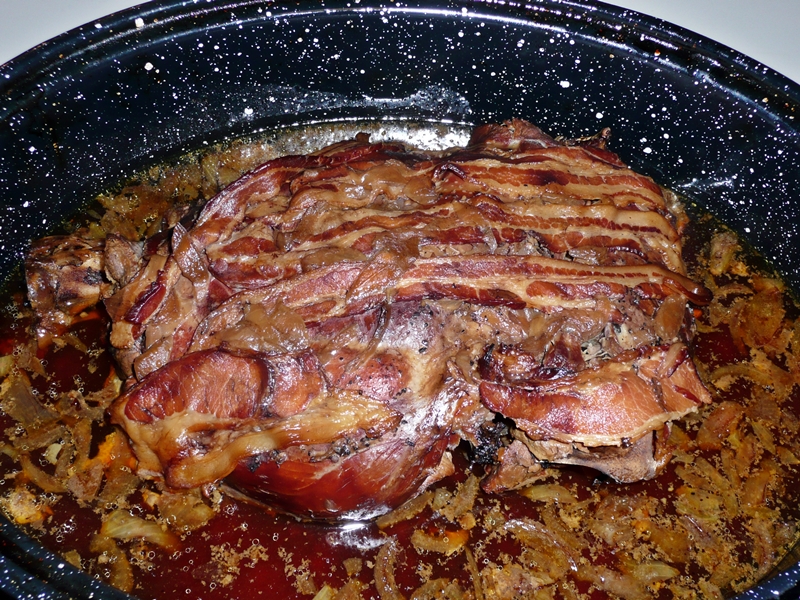
Some time back, in one of her daily blogs on Blind Pig & the Acorn, Tipper Pressley (a good friend and the webmaster whose efforts make this monthly e-newsletter possible) provided a recipe for a venison roast. It wasn’t actually her recipe but rather one her husband prepared. I filed it away in the back of my mind, knowing that I wanted to try it at some point. The late-season doe mentioned above provided the perfect opportunity. I followed the instructions Tipper offered fairly closely, but as is often the case, I just had to change a few things. Here’s what I did, and let me assure you the end result was far and away the best venison haunch I’ve ever had.
Begin with a half inch or so of water in a large roasting pan. In a skillet melt a stick of butter and sauté a sweet onion in it (the original recipe used two tablespoons of minced garlic). When the onion is translucent pour the mix over the ham. I sprinkled Montreal Steak Seasoning atop the meat while Tipper’s recipe called for salt, pepper, and Old Bay. Drizzle honey atop the ham and anoint with a small amount (I used two tablespoons) of apple vinegar. Then cover with slices of bacon, using wooden toothpicks to anchor them in place. Cook in a 220-degree oven for nine hours. I checked every couple of hours and spooned the water/butter mix in the bottom of the roasting pan over the meat. When finished, it sliced with incredible ease and was wonderfully tasty. My only complaint, and it is always an issue with venison, is that the slices of meat were a bit dry. Putting drippings over them solved that issue, and I could have made gravy as another solution. The next time I cook a roast I’ll also cover the entire top with slices from a tart apple such as a Granny Smith or Stayman.
There’s lots of leftovers simply because a venison ham represents several pounds of meat. However, I have the perfect use for them. They will form the basis or backbone for venison vegetable soup (see below).
VENISON VEGETABLE SOUP
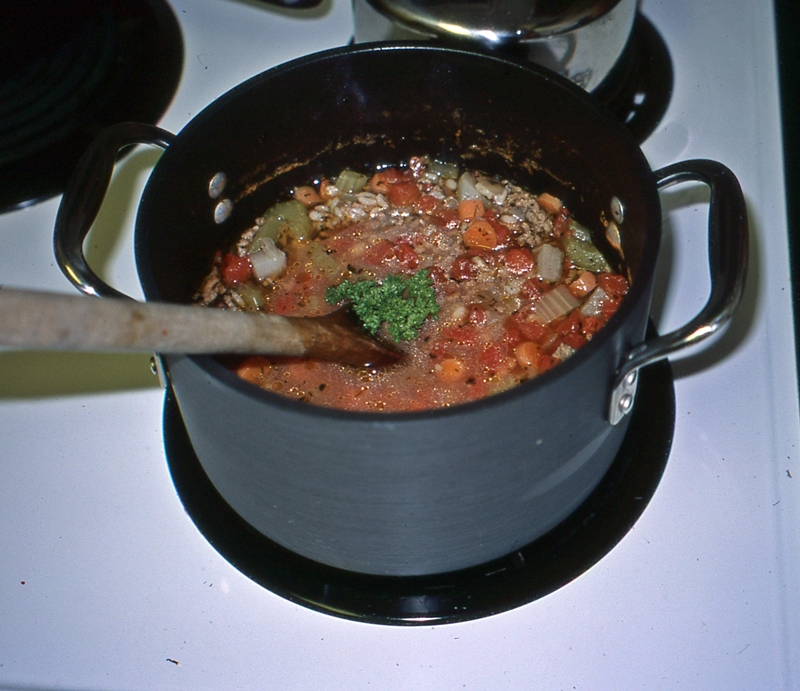
For the most part, my venison vegetable soup has a bit of an aura similar to what was sometimes called “mystery meat” when I was in college. The implication was, of course, that no one knew precisely what it was. In the case of the meat in my soup that certainly isn’t true. It’s always venison although it might come in the form of burger, stew meat chopped into small pieces, or in the present case, leftover meat from the roast.
The mystery, or more accurately the unpredictability, comes with the vegetables. For the most part I simply freeze and save leftovers, use small freezer packages from a “run” of some summer vegetable where there isn’t enough for another full container, and add whatever I think appropriate. Tomato juice is a constant in the soup, as are onions. Beyond that there might be corn, lima beans, green peas, green beans, crowder peas, chunks of tomato, potatoes, celery, carrots, yellow summer squash, zucchini, or other vegetables. In addition, I always use either barley (one of my favorite ingredients in soup) or some type of pasta. The latter might be pasta shells, macaroni, spaghetti, or some other form.
I begin by browning the venison, unless it is already cooked, in a bit of olive oil. In the present case I’ll chop to slices of roast fine using an ulu (an Eskimo knife that belongs in every kitchen) and add plenty of the broth saved from the original preparation. To that I’ll add tomato juice (you can use juice you have put up or buy either regular tomato juice or V-8 juice) and some diced tomatoes or whole tommytoes. I freeze the latter in quart bags, leaving the skins on them. I’ll start that to simmering and add any vegetables which have not been previously cooked at this point.
This “starter” simmers until the vegetables are done—carrots and potatoes take a fair bit of time but are easily tested with a fork. At that point I add the previously cooked and saved vegetables and barley or pasta. Allow to continue to simmer until the pasta is done, season with salt and black pepper as needed, and if you like the flavor perhaps add some Italian spice mix.
While the soup is simmering and the venison and veggies making a wonderful marriage of flavors, bake a pone of cornbread, timing it so it comes out of the oven about the same time as the soup is ready to serve. With the addition of some fresh fruit or maybe a green salad as a side, you have some wonderfully hearty winter eating. A cobbler, perhaps baked before the corn pone, can be a satisfying sweet finish.
VENISON SCHNITZEL
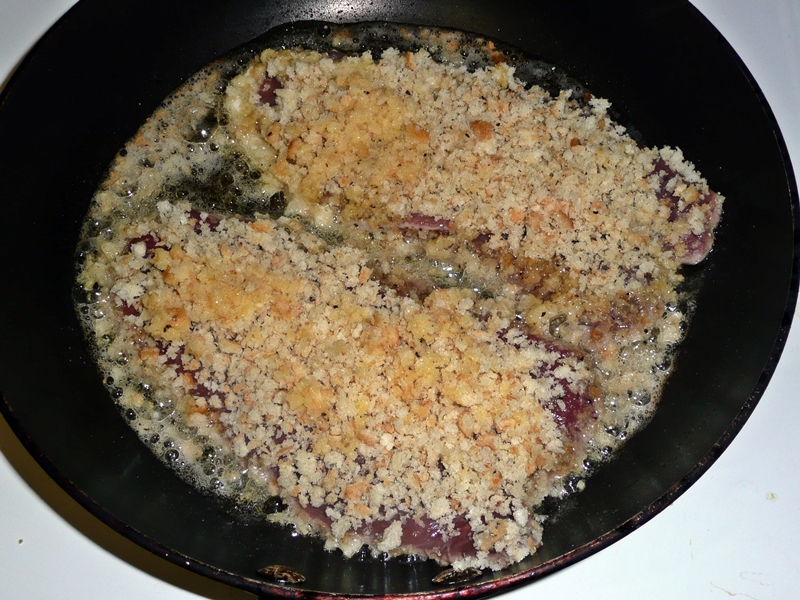
There are several keys to making scrumptious venison schnitzel. First and foremost, you want your cutlets of meat to be really tender. I achieve this in one of two ways. The first is to take cubed steak and use a meat hammer or mallet to tenderize it even more. I have a heavy device which has a handle with a face covered with triangular-shaped teeth below it. You pound straight down with it so that all the force goes directly into the meat. I find it far superior to the standard meat hammer.
A second option, and if you really like schnitzel you’ll agree it is worth it, is to use backstraps to prepare the dish. Some will argue that is almost a crime, taking the finest cut of a deer (along with the loins) then pounding it before frying, but I find it difficult to argue with “melt in the mouth” goodness that is the end result.
2 pounds venison cutlets, tenderized and pounded thin
Flour
Panko crumbs
3 eggs, beaten thoroughly
½ teaspoon paprika
½ teaspoon black pepper
1 tablespoon garlic salt
Olive oil
Dredge each cutlet in flour, then in egg batter, and finally in Panko crumbs. This is best done with a two-pronged kitchen fork. Gently place each covered cutlet in a pan which has enough olive oil (pre-heated) to cook well. Be sure that the oil is hot enough to brown the down side of each cutlet almost immediately, and if they begin to cook too rapidly, cut back on the heat. Never, ever put the meat in before the oil is fully heated. If you do so the coating will soak it up and make a greasy mess instead of browning nicely. Cook cutlets until nicely browned on either side, turning only once before setting finished cutlets atop paper towels until all have been cooked. Top with a sprinkle of chopped parsley or chives along with lemon wedges. A green vegetable, mashed or roasted potatoes, or buttered noodles all make nice side dishes.
QUICK CUBED STEAK
My favorite way to prepare cubed steak is to flour, brown in olive oil, then cook in a crockpot with a can of mushroom soup for several hours, adding rice in the final stage and cooking until the rice is done. However, that’s a slow process, one requiring planning ahead of time, and simply frying cubed steak is almost as good. That’s especially the case if you make some milk gravy to accompany it.
Prepare cubed steaks by doing some extra pounding to tenderize and then dredge in flour. Heat olive oil in a skillet so that the meat, when introduced, browns quickly. Do not overcook. The cubed steaks should be pink in the middle when they come from the pan. Allow to drain atop paper towels, and if you are cooking for a lot of people you can “hold” the finished steaks in a warm oven until all the meat has been fried.
SPICED OVEN PEACHES
Every summer I buy a couple of baskets of peaches, eating them fresh in glorious fashion (by themselves, atop ice cream, on cereal, in cobblers, and the like) but I also freeze a number of containers. In the cold weather months it’s nice to take out a container for a cobbler, but another think I like to do is to pour a container of just thawed peach slices into a baking dish, sprinkle them with brown sugar, a bit of cinnamon, and a hit of allspice. In addition, I drizzle a small amount of honey atop them. Place the baking dish in a 325-degree oven and cook until bubbling or you see the first hints of brown on exposed peach edges. Normally, unless the peaches are late-season ones which have less juice than those from the height of summer (Loring and Red Haven are favorites of mine), they will produce plenty of juice on their own while cooking. If necessary though, you can add a small amount of water. Serve as a side dish or dessert.